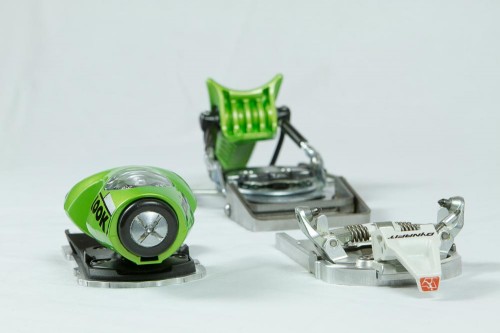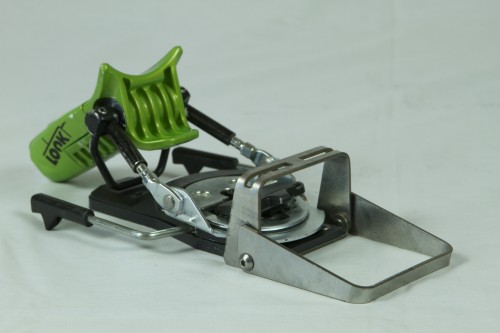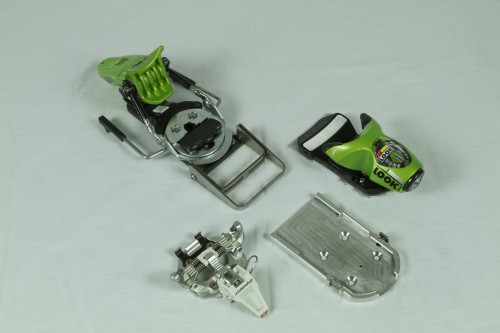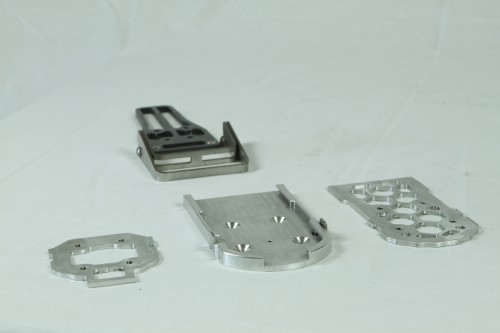CAST Si&I Binding System Review
(Last Updated On: )
Cast Touring’s Si&I binding system is the final production model of what has been one of the most closely-watched developments in the exploding market of ski touring technology. Brothers Lars and Silas Chickering-Ayers, both renowned freeskiers sporting numerous wins on the prestigious Freeskiing World Tour and Freeride World Tour competition circuits, have spent nearly six years developing and prototyping the system. After a successful Kickstarter campaign to fund the first round of production the Si&I system will ship in time for the 2013-2014 ski season.

Lars, Silas, and their close friend Ryan Hawks began looking for a way to improve on the current state of alpine touring binding technology some eight years ago. They knew that they wanted to combine the ability to release the heel and pivot off the toe for touring with a no-compromise binding: something that would allow them to ski big, fast, committing lines far outside the boundaries of ski resorts. Their first attempt was a long metal plate that sat on the ski to which they would mount a traditional alpine race binding. The plate could be locked or released at the heel, allowing for a slightly awkward but functional uphill stride. Unsatisfied with the stride and weight of the system, they moved to the first prototype of the system they will take to production in the fall.
The Si&I system instead relies on a low-tech touring toe-piece (for this year the only option is a Dynafit Radical toe) to deliver the walk mechanism. This means far greater walking efficiency by way of a perfectly-placed pivot point and greatly reduced stride weight, as the heavy heel piece stays on the ski. Cast accomplishes this by mounting a metal housing to the ski where the toe piece would be, and mounting both the Dynafit Radical toe and the alpine binding toe to metal slider plates. Thus, when you want to go up you slide the Dynafit toe into the housing and lock it in place with a simple side-to-side click, much like a gun safety, and to ski you remove the Dynafit toe and replace it with the alpine toe. The binding heel piece is mounted on a small riser plate to account for the stack height added to the toe by the housing and slider plate (7mm) to keep the ramp angle of the binding from changing. Incorporated into the heel riser plate is the heel lift mechanism, a set of two pole-activated metal bars that give the user the option of flat, 7º or 14º heel lift while touring.

I spent the entire 2012-2013 season skiing on a prototype of the Si&I system. To give some background, I have been ski touring since the ‘05-’06 season, when I lived in Little Cottonwood Canyon in Utah and toured in the Wasatch on my days off. I had been dabbling in telemark skiing that season, and began my backcountry adventures on tele bindings (22 designs Hammerhead). I quickly realized the limitations involved with having to fight the spring on a tele binding with every step and traded my tele gear for a set of Dynafit Comforts and Scarpa Magic boots. I skied Dynafits in the backcountry for the next 4 seasons, in Vermont, Utah, and Colorado, but while I loved the efficient pivot point, light weight, and ease of use, I never felt comfortable enough in the bindings to really let loose and ski hard in the backcountry. My second year here in Crested Butte I traded everything I had for the new Marker Duke bindings and a pair of the heaviest, burliest touring boots I could find (Black Diamond Factor 130). This setup opened up a new world to me, one where I could ski fast, hit cliffs, and take chances outside of the comfort of a ski area, but as I began to explore this new world I finally realized where my true priorities lay. I ditched first the Factors, then the Dukes in favor of race-stiff, plastic soled alpine boots (no walk mode) and Backcountry Access’ first and only offering to the touring binding market, the Alpine Trekker. I found I was perfectly willing to lug around all that extra weight and discomfort (no walk mode!!??!) for the opportunity to ski anything, anywhere, anytime on my preferred Look P18 bindings and Tecnica R9.8 boots.
So that’s me, and how I came to be interested in Lars and Silas’ project. I ran into them skiing the prototypes in Chile in 2011, and immediately begged them to let me try a prototype. Though the prototypes that I have are still a little rough around the edges, I was immediately impressed with how well they worked for my touring style.

Pros:
– Light. Well, light compared to Alpine Trekkers, which add a pound or more to each foot while hiking and make you fight a return spring with each step and then sit clumsily and heavily in your pack while you’re trying to ski, and light compared to Dukes, which are lighter than the prototypes I have been skiing, but require you to lift nearly the entire weight of the binding with each step. My prototypes, including the 2550g Look P18 binding, weigh approximately 3700g. That is a lot. That is heavier than Salomon STH 16 Steels, which are the heaviest binding available, and not even in the same realm as Dynafit Radical FTs, which weigh only 599g for a pair. However, I found that the Cast prototypes had a significantly lighter feel on my foot than the Dukes. Part of this is because when you tour, the heavy alpine toe sits in your pack and the lighter Dynafit Radical toe is on the ski, greatly reducing the weight that you are pulling up the hill with each step. The other major factor is that with the Cast system you are lifting only the weight of your ski boot, as the only attachment is via the tech inserts in the boot toe.
– Look P18. Whether or not they are necessary for all of the skiing I do, or even any of the skiing I do, I always feel better with these on my feet. They have a rigid and secure interface with both the ski and the boot, they have a ton of elastic travel allowing them to let your boot most of the way out of the ski in a fall and still snap it back in if the force causing the release disappears, and their vertical toe release and rotating heel allow for release in almost any direction. In short, they keep you firmly attached to your skis when you want to stay that way, and let you go when needed. Skiing P18s makes me far less nervous in the backcountry that I will blow my knee from a ski not releasing or that a ski will come off at an inopportune moment and cause an unnecessary fall. There is a reason current P18s are functionally identical to bindings that Look was making in the ‘80s: they just work.
– Stability. When touring uphill on the Si&I the boot to ski interface is the tightest one on the market. It feels exactly as rigid as using a low tech toe piece mounted directly to the ski. The only difference is the additional 7mm stack height. Similarly, skiing in the system feels just as rigid and powerful as does a P18 mounted straight to the ski. I found the weight difference noticeable, which I will cover in the “Cons” section below.
– Confidence. The bottom line for me while touring on the Si&I was that I always had my favorite skis, boots, and bindings between me and the snow, and that felt good.
Cons:
– Heavy. I know I said they were light before, but that was when I was skinning. When skiing, boot packing with the skis on my pack or riding the chairlift I found the added weight of the system very noticeable. I thought that the additional weight of the toe housing and toe plate made my skis feel much heavier and more cumbersome, harder to spin or reposition in the air, less lively, and occasionally painful on my knees while riding chairs.
Luckily: much of this has been addressed in the production model. My prototypes added some 600g per foot to the weight of the P18, where the production model Si&I will add only 250g per foot while skiing and while touring it will decrease the weight on the ski by 142g. This was accomplished by making the housing much smaller and machining out material on the bottom of the slider plate and on the base of the housing. I have yet to ski the new model but I am hopeful that the weight reduction will minimize the issues I experienced.

– Slow. When I was on Dynafits, I could make a change-over in a matter of seconds. It was always nice to get to the top of a line and just rip skins and go, especially if it was cold and/or windy. On Dukes, I was so much happier with skiing performance that I was willing to spend sometimes upwards of 5 minutes carefully scraping every last bit of ice from the track system so that they would re-enter ski mode without breaking the all-important lever.
The Si&I prototype took me approximately as long as the Duke. On the prototypes the toe plates were held in place by a long hitch pin much like the ones found on splitboard bindings. Users have the options of removing the brakes from their bindings or using a rubber band or ski strap to secure them while in tour mode. I chose to use the thick, burly rubber bands that ski shops use to hold the brakes out of the way while tuning. This has been a major sticking point for many people on the system so let me make this very clear. THIS IS NOT A BIG DEAL. I use the rubber bands to keep my skins nice and tidy in my pack, and when I put the skins on I put the bands on the brakes. It takes all of maybe 6 seconds for both skis, and is definitely the fastest part of the change-over process. I did occasionally end up with ice in the toe housing which caused the plate to stop, blocking the pin. This is annoying, but easier to fix than iced up Dukes. The only other issue with the change-over is that, on the prototypes at least, I had to keep track of P18 toes, Dynafit toes, pins, and rubber bands. Losing any of these things could turn a good day bad in a hurry. I never lost anything, but it was always on my mind.
Luckily: The pins, which were prone to bending and getting lost, are gone. The new model Si&I has a metal slider towards the front of the toe housing that clicks side to side, locking the plate in place to the right and freeing it to the left. This mechanism has a solid “thunk” of a click and is much more reassuring than the pins I used. This should also shave a fair amount of time and stress off the change-over process, as it is several seconds faster than the pin (even when the pin works perfectly) and impossible to lose.
– Must click out to change modes. There is unfortunately no way to switch from walk to ski or vice versa without taking off your pack, clicking out, and doing the whole change-over process. This can make rolling terrain or a long cross country ski after a descent more of a burden than with a binding that switches easily like the Salomon Guardian or Fritschi Freeride Pro.
– Boot Modification Requirement. Well, sort of. The only boot currently available that will work unmodified in the system is the new K2 Pinnacle line of touring boots. They feature both manufacturer installed tech inserts (Dynafit) and a sole compatible with DIN release standards. Another option is to use a touring boot with the sole ground down by 2mm to be the same thickness as a DIN standard sole. This season I used Tecnica Cochise 130 Pro boots with a little bit of grinding and felt that they released reliable and consistently, but I never had this confirmed at a ski shop. The no-compromise option, around which Cast designed the Si&I system, is to use their in-house boot modification. They grind out a bit of the boot sole, screw and epoxy in a set of tech inserts, and replace the ground out sole material with a race-style riser plate. I have not tested this boot modification, but it has been in use by Lars and Silas for two seasons. Hopefully, more companies will begin to offer a tech and DIN compatible sole option, especially for interchangeable soled touring boot options.
Bottom Line:
This system is not for everyone. It probably isn’t even for most people. But it is very nearly perfect for me. For whatever reason, I depend heavily on my equipment. Whether it is my skiing style, imperfect technique, typical line choice, or even just something in my head, I am unable to fully enjoy or appreciate a ski if I feel like I am fighting my equipment or worse, unable to depend on it to have my back. If I am not in P18s and a race-level alpine boot I do not feel comfortable skiing technical lines either inbounds or in the backcountry. For me, Dynafits are not an option because I simply do not feel like I can trust them to release when needed and only when needed. Compared to the other options available the Si&I system has a much lower stack height than the Marker Duke and Tyrolia Adrenaline, weighs less than the Salomon Guardian, and most importantly uses a proven binding platform that I trust implicitly. With the Si&I I found I was able to ski demanding, high speed, and technical lines both inbounds and in the backcountry, all on the exact same gear.
Painter, skier, and aspiring brewmaster Tom Runcie can be found on the slopes of Crested Butte and the surrounding backcountry. His website can be found here.
You’ll have to put your new bindings on something. Start shopping:
- Where to Find the Best Off-Piste Skiing in the Alps - November 11, 2018
- Top 5 Gadgets for Long Hikes - July 16, 2017
- Best Hikes for Any Time of Year - October 16, 2016

Pingback: Cast Touring Si&I Binding System Review | Tom Runcie